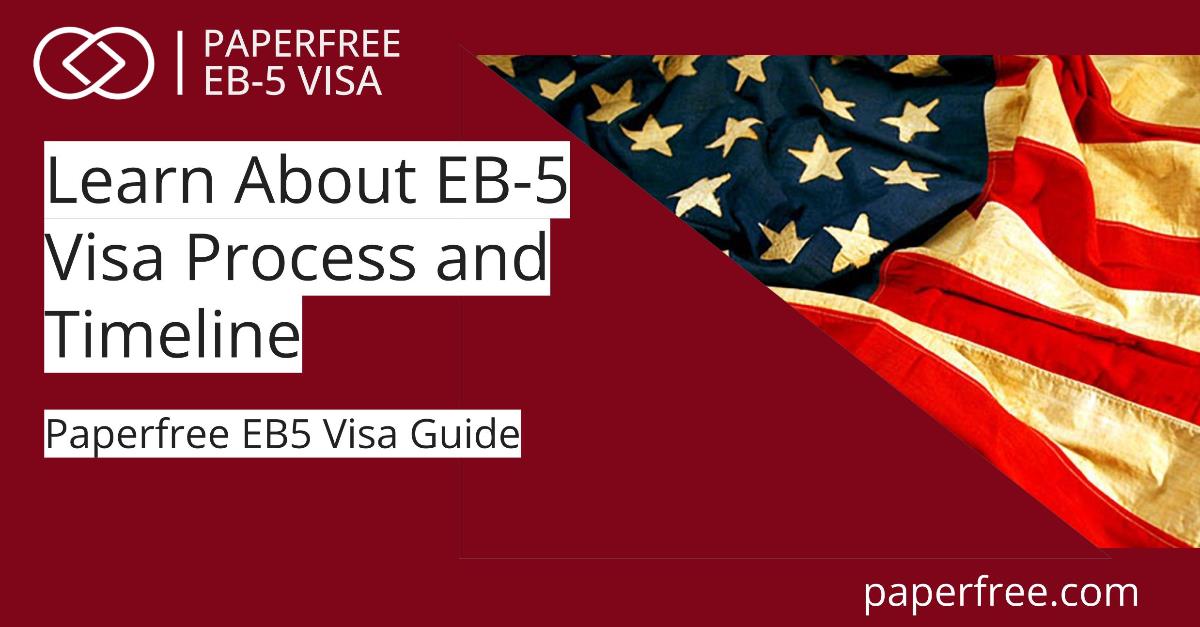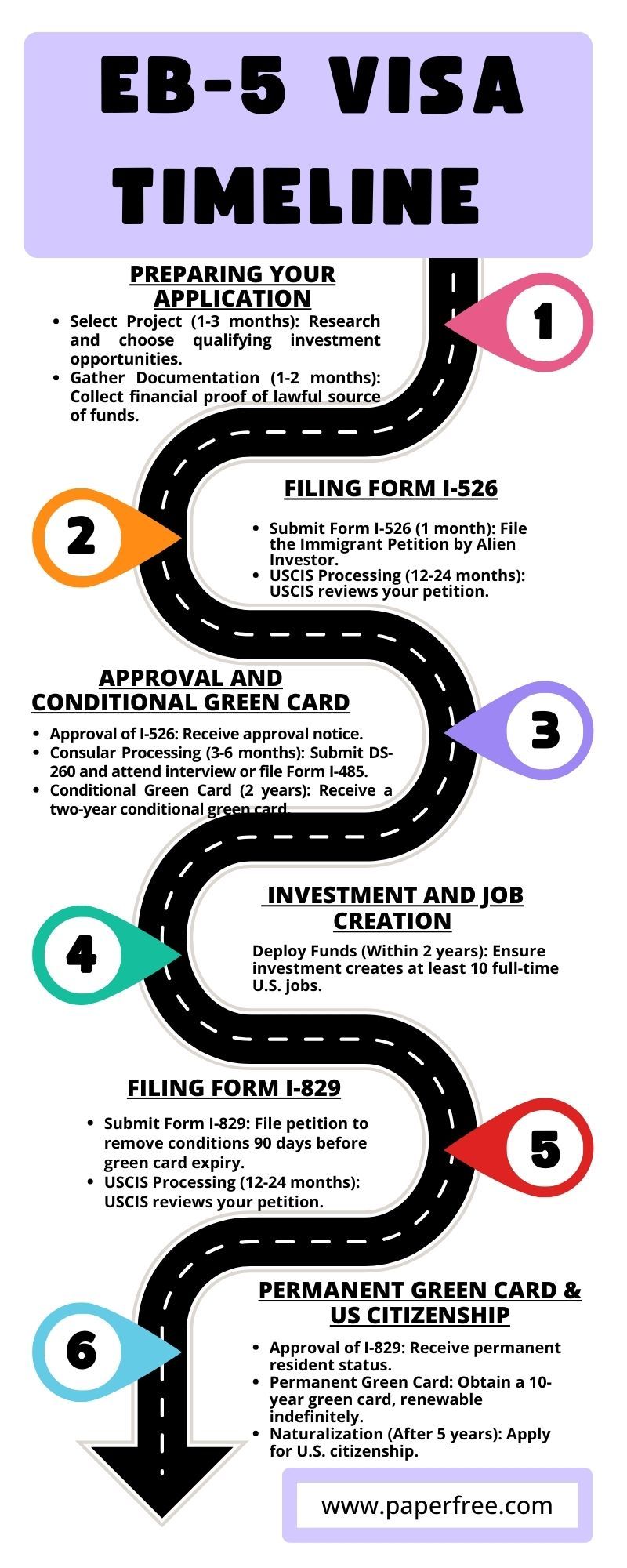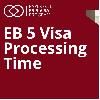EB5 Program Timeline: All You Need to Know.
Understanding the EB-5 Timeline: Your Ultimate Guide to a Smooth Immigration Journeylast updated Tuesday, June 10, 2025
#eb-5 timeline #eb 5 program timeline
| | by Sidra Jabeen | Content Manager, Paperfree Magazine |

QUICK LINKS
AD
Get Access to EB 5 Investment Visa Resources
Key Points:
The EB5 Visa Process | EB 5 Visa Timeline Simplified:
- Step 1 – Select an EB-5 project
- Step 2 – Make the investment
- Step 3 – File form I-526E/I-526
- Step 4 – Receive a conditional Green Card
- Step 5 – Removal of conditions
- Step 6 – Become a permanent resident
- Step 7 – Apply for U.S. citizenship
Understanding the EB-5 timeline is critical for prospective investors as it outlines the procedural milestones and requisite timelines for obtaining permanent residency. Each stage in the EB-5 process entails specific requirements and timeframes, influencing the investment strategy and immigration planning. Comprehensive knowledge of this timeline ensures that investors can make informed decisions, manage expectations, and effectively coordinate with legal and financial advisors to streamline the application process.
This blog aims to provide a detailed, step-by-step guide to the EB 5 program timeline, from initial preparation to obtaining a permanent green card. By breaking down each stage of the process, this guide intends to demystify the EB-5 program, highlight critical considerations, and offer practical insights to prospective investors, ensuring a clear understanding of the procedural and chronological aspects of the EB-5 journey.
For a detailed look at how the EB-5 visa timeline can vary depending on your country of origin, check out our comprehensive article on EB-5 visa processing time by country.
Overview of the EB 5 Visa Timeline

General Steps Involved in the EB-5 Process
- Initial Preparation: Selecting a qualified EB-5 project, securing the investment amount, and gathering necessary documentation.
- Filing the I-526 Petition: Submitting the immigrant petition by an alien investor (Form I-526) to the United States Citizenship and Immigration Services (USCIS).
- Conditional Permanent Residency: Upon approval of the I-526 petition, you can apply for a two-year conditional green card.
- Filing the I-829 Petition: The investor submits the petition to remove conditions on their permanent resident status (Form I-829).
- Permanent Green Card: Approval of the I-829 petition grants permanent resident status, leading to eligibility for U.S. citizenship.
Average Duration of Each Step: EB5 Visa Processing Time
- Initial Preparation: 3-6 months, depending on project selection and document preparation.
- Filing the I-526 Petition: 12-18 months for USCIS processing.
- Conditional Permanent Residency: Approximately 6-12 months after I-526 approval.
- Filing the I-829 Petition: 3-6 months for preparation and submission, followed by 24-30 months for USCIS processing.
- Permanent Green Card: Achieved after I-829 approval, typically within 4-5 years from the initial investment.
Detailed Breakdown of the EB 5 Investment Timeline
1. Initial Preparation
Choosing a Qualified EB-5 Project
Selecting a project with a proven track record, financial viability, and compliance with EB-5 requirements is crucial. Engaging with reputable regional centres and conducting thorough due diligence can mitigate risks and ensure project success, considering the EB-5 direct investment timeline.
Securing the Investment Amount
Investors must ensure the availability of the required capital sourced from lawful means. This step involves financial planning, securing necessary funds, and documenting the source of investment to comply with USCIS regulations.
Gathering Required Documentation
Comprehensive documentation, including personal identification, financial records, and investment agreements, is essential for the I-526 petition. Meticulous preparation and organisation of these documents facilitate a smoother filing process.
2. Filing the I-526 Petition
Process of Filing the I-526 Petition
The I-526 petition, submitted to USCIS, demonstrates the investor's eligibility and the project's compliance with EB-5 requirements. It includes detailed information about the investor, the investment, and the project.
Required Documentation for I-526
Key documents include proof of investment, source of funds, business plan, economic impact analysis, and regional centre approval (if applicable). Accurate and comprehensive documentation is critical for a successful petition.
Processing Time for I-526 Petition
The average processing time for the I-526 petition ranges from 12 to 18 months, subject to USCIS workload and case complexity. Regular follow-ups and timely responses to USCIS requests can expedite the process.
3. Conditional Permanent Residency
Approval of I-526 and Obtaining a Conditional Green Card
Upon I-526 approval, investors apply for conditional permanent residency through consular processing or adjustment of status. This stage involves medical examinations, interviews, and additional documentation.
Travel and Work Rights with a Conditional Green Card
Conditional green card holders enjoy the right to live, work, and travel within the United States. They must adhere to their residency conditions and fulfil employment creation requirements.
Two-Year Conditional Residency Period
The two-year conditional residency period allows investors to meet the job creation requirements and fulfill other EB-5 obligations. During this period, timely preparation for the I-829 petition is essential.
4. Filing the I-829 Petition
Process of Filing the I-829 Petition
The I-829 petition seeks to remove the conditions on permanent residency by demonstrating that the investment met the job creation requirements. This petition includes updated project and employment documentation.
Required Documentation for I-829
Documentation includes proof of job creation, evidence of sustained investment, and compliance with EB-5 regulations. Comprehensive and accurate records are vital for a successful petition.
Processing Time for I-829 Petition
The processing time for the I-829 petition typically ranges from 24 to 30 months. Prompt and accurate responses to USCIS requests for evidence (RFEs) can influence the processing duration.
5. Permanent Green Card and Beyond
Approval of I-829 and Obtaining Permanent Green Card
Upon approval of the I-829 petition, investors and their dependents receive permanent green cards, granting them unconditional permanent residency in the United States.
Rights and Responsibilities of Permanent Residents
Permanent residents enjoy full rights, including work authorisation and travel flexibility. They must adhere to U.S. laws, file taxes, and fulfill residency requirements to maintain their status.
Path to U.S. Citizenship
Permanent residents may apply for U.S. citizenship after five years of residency, subject to eligibility criteria such as continuous residence, good moral character, and knowledge of English and U.S. civics.
Factors Influencing the EB-5 Timeline
Project Selection and Regional Center Involvement
Choosing the right EB-5 project and regional centre is crucial for a smooth and timely application process. Projects affiliated with reputable regional centres often have pre-approved business plans and economic impact analyses, which can expedite the approval process. Additionally, projects with a proven track record of job creation and compliance with EB-5 requirements are less likely to encounter issues that could delay the timeline. When selecting a project, ensure thorough due diligence to avoid any potential pitfalls that could extend the EB-5 timeline.
Investor's Country of Origin and Visa Bulletin
The investor's country of origin significantly impacts the EB-5 timeline due to visa availability and the Visa Bulletin. Countries with high demand for EB-5 visas, such as China and India, often face longer wait times due to visa retrogression. The U.S. Department of State's Visa Bulletin provides monthly updates on visa availability, indicating when investors from specific countries can proceed with their applications. Keeping track of the Visa Bulletin and understanding its implications is essential for managing expectations and planning accordingly.
USCIS Processing Times
USCIS processing times vary depending on the workload, complexity of cases, and other factors. Delays in processing I-526 and I-829 petitions can extend the eb5 visa timeline. Monitoring USCIS processing times and staying updated on any changes or backlogs is critical. If available, investors can also consider premium processing options to expedite certain stages of the process.
Legal and Financial Preparations
Proper legal and financial preparations are fundamental to a smooth EB-5 process. Engaging experienced immigration attorneys and financial advisors can help ensure that all documentation is accurate, complete, and submitted on time. Legal and economic hurdles, such as proving the lawful source of funds or addressing compliance issues, can cause significant delays if not handled promptly and efficiently.
EB5 Green Card Timeline: Common Challenges and How to Overcome Them
Delays in Document Preparation
During the eb5 green card timeline one of the most common challenges in the EB-5 process is delays in preparing and gathering necessary documents. Ensuring that all required documentation is accurate and complete is essential to avoid requests for evidence (RFEs) from USCIS, which can significantly delay the process. Maintaining organized records and working closely with legal and financial advisors can help mitigate this challenge.
Issues with Project Compliance
Projects must meet specific requirements to qualify for the EB-5 program. Issues with project compliance, such as failing to create the required number of jobs or not adhering to business plans, can result in delays or denials. Conducting thorough due diligence before investing and continuously monitoring the project's progress can help ensure compliance and avoid potential issues.
Navigating the Visa Bulletin
Navigating the complexities of the Visa Bulletin can be challenging, especially for investors from countries with high demand for EB-5 visas. Understanding the visa allocation process and planning accordingly can help manage expectations and avoid surprises. Consulting with immigration experts with experience with the Visa Bulletin can provide valuable insights and guidance.
Legal and Financial Hurdles
Legal and financial hurdles, such as proving the lawful source of funds or meeting investment requirements, can pose significant challenges. Addressing these issues promptly with the help of experienced legal and financial professionals can prevent delays and ensure a smoother process. Proactive planning and thorough documentation are crucial to overcoming these hurdles.
Tips for a Smooth EB-5 Process
Choosing Reliable Legal and Financial AdvisorsSelecting reliable and experienced legal and financial advisors is crucial for navigating the EB-5 process smoothly. These professionals can guide document preparation, compliance issues, and other critical aspects of the EB5 Timeline. Ensuring that you have a competent team in place can make a significant difference in the efficiency and success of your application.
Staying Organized and Keeping Track of DeadlinesMaintaining organised records and tracking deadlines is essential for a smooth EB-5 process. Please submit complete documentation to avoid delays or denial. Using checklists, calendars, and reminders can help ensure that all necessary steps are completed on time.
Regular Communication with the Regional CenterI think regular communication with the regional centre is essential to stay updated on the project's progress and compliance status. This can help identify and address potential issues early on, preventing delays and ensuring that the investment meets all EB-5 requirements.
Being Proactive in Addressing Potential Issues
Addressing potential issues, such as legal and financial hurdles or compliance concerns, proactively can prevent delays and ensure a smoother process. Regularly reviewing and updating documentation, staying informed about regulation changes, and consulting with experts can help mitigate risks and keep the EB5 program timeline on track.
Read our comprehensive guide about EB-5 processing time by country for more details.
Frequently Asked Questions
What is the average processing time for an EB-5 application?
The average processing time for an EB-5 application varies by stage. Initial preparation and document gathering can take 3-6 months. The I-526 petition processing time is typically 12-18 months. A conditional green card takes approximately 6-12 months after I-526 approval. Filing the I-829 petition can take 3-6 months, with USCIS processing times of 24-30 months.
How can I expedite my EB-5 application?
An EB-5 application can be expedited by ensuring complete and accurate documentation, choosing a reputable regional centre, and staying organised. Premium processing options, when available, can also speed up certain stages of the process.
What is EB-5 visa premium processing?
EB-5 visa premium processing is an expedited service offered by USCIS to shorten the adjudication time for certain immigration petitions. While traditional EB-5 visa processing can take several years, premium processing aims to provide faster decision-making, potentially within a few months. However, this service may only be available for specific stages or types of EB-5 applications and may come with additional fees.
What are the main factors that can delay my EB-5 application?
Common factors that can delay an EB-5 application include document preparation delays, issues with project compliance, visa retrogression, and USCIS processing times. Addressing these factors proactively can help minimise delays.
Can I travel outside the U.S. during the EB-5 process?
Conditional green card holders can travel outside the U.S. but must maintain continuous residence and comply with travel restrictions. Consult with an immigration attorney to ensure compliance with travel requirements during the EB-5 process.
How long does it take to get a permanent green card through the EB-5 program?
Obtaining a permanent green card through the EB-5 program typically takes 4-5 years from the initial investment, depending on various factors such as USCIS processing times and visa availability.
What happens if my I-526 petition is denied?
If an I-526 petition is denied, investors can address the reasons for the denial and refile the petition. Consulting with an experienced immigration attorney can help identify issues and improve the chances of approval upon reapplication.
Conclusion
Understanding the EB-5 timeline is essential for prospective investors to navigate the process smoothly. From initial preparation to obtaining a permanent green card, each stage requires careful planning, documentation, and compliance. Given the complexities and potential challenges of the EB-5 process, it is crucial to seek professional guidance from experienced legal and financial advisors. Their expertise can help streamline the process and increase the chances of a successful outcome. The EB-5 program offers a valuable pathway to U.S. residency, but it requires meticulous preparation and adherence to timelines. Investors can successfully navigate the EB-5 journey by staying informed, organised, and proactive.
For personalised assistance and expert guidance on your EB-5 journey, please consult with our team of experienced EB-5 professionals. Paperfree is here to help you every step of the way.
Pages Related to #eb-5 timeline
- EB5 Investment Visa Guide 2025

- Best EB5 Regional Center List | American EB5 Regional Center

- Paperfree Investment Visa EB-5 Program is Your Your Clear Path to Green Card USA

- EB 5 Visa Requirements 2024, A Guide To on eligibility for U.S. Investment-Based Residency

- EB5 Processing Time: A Journey Towards Green Card 2026 | Paperfree.com

- EB-5 processing time by country updated 2026

- EB-5 Visa Residency Requirements. Is EB 5 Visa for Me? Other visa options EB5 vs E2 vs L1

- EB-5 Integrity Fund Updates for Fiscal Years 2023 and 2024

Popular Page
Benefits of the EB-5 Visa Program| A Comprehensive Guide
Book a Free Complimentary Call
real estate investing Investment Visa USA Investment Magazine Private Real Estate Funds real estate funds

